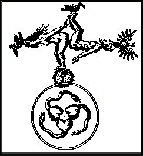|
|
Principe had been reading alchemical writings. He knew
"like Ice in luke-warm water" was a simile employed by
17th-century alchemists as they sought the so-called
Philosopher's Stone, the elixir that would transmute base metals
into gold. If the author of these pages used that phrase, then
the author was describing transmutation in the language of an
alchemist. And what gave Principe a rush, was that the author was
Robert Boyle, the man regarded as the father of modern
chemistry.
Boyle (1627-91) and contemporaries Isaac Newton and John Locke
were, in the eyes of historians, the founders of the scientific
method, the men who led natural philosophers--the scientists of
the day--away from occult practices like alchemy into the light
of rational, objective, experiment-based science. Biographer
after biographer and historian after historian had missed or
dismissed previously noticed hints of Boyle's interest in
transmutation. But Principe knew in his gut that Boyle was not
likely to have written "like Ice in lukewarm water" unless he had
been an alchemist.
Principe spent the next eight years assembling his argument, and
in The Aspiring Adept: Robert Boyle and His Alchemical
Quest (Princeton, 1998), he makes his case: The "father of
modern chemistry," says Principe, spent 40 years seeking the
recipe for the Philosopher's Stone and carrying out alchemical
experiments. He did all those scientific things for which he's
justifiably famous, including discovering Boyle's Law of Gases.
But he was also an active and enthusiastic alchemist. Writing
about the book, Seymour Mauskopf, professor of history of
chemistry at Duke University, said that it "will stand the
traditional view of Boyle as a progenitor of modern science on
its head."
Which is okay with Principe. He says, "I can think of a few
historians who are going to have a conniption." He smiles when he
says it.
PRINCIPE, A 36-YEAR-OLD ASSISTANT PROFESSOR at Hopkins, occupies
a Mergenthaler Hall office cluttered with the materials and
artifacts of his three scholarly pursuits. He holds a joint
appointment in the departments of Chemistry
and
History of Science, and is unofficially a one-man department
of alchemy.
Books and papers are everywhere, even stacked on the steps of a
wooden ladder. A fume hood for chemical procedures dominates one
wall. Principe's office has become a de facto museum for the
history of chemistry at Hopkins. He keeps a brace of beautiful
old balances, and a voltmeter and ammeter from the 19th century.
On the wall behind his computer hangs a framed portrait of Robert
Boyle. Principe has noticed that for some reason many paintings
of alchemists included wildlife specimens scattered about the
lab. Principe, who in another century might have been an adept
himself, as those who "knew" the secret to transmutation were
called, has suspended a preserved blowfish from his ceiling. He
says he's on the lookout for a stuffed crocodile.
Larry Principe was one of those kids who periodically used a home
chemistry set to pervade the basement with noxious fumes. "Our
house must have been well-ventilated," he says, "since I didn't
kill myself. My parents did buy me a couple of fire
extinguishers." He also collected 19th-century books on
chemistry, and recalls a library volume on alchemy that prompted
a question that would linger in his mind as he attended the
University of Delaware: "I began to wonder if anyone had tried to
find out what these people really had been doing."
In 1980, Principe was a sophomore majoring in chemistry and
liberal studies (he tends to pick up degrees in pairs) when
Delaware purchased an uncataloged library of several thousand
books on the history of chemistry. He could not have been
happier. The faculty gave him permission to go through the
collection, and he came across a 1604 first edition of
Triumph-Wagen Antimonii, or The Triumphant Chariot of
Antimony, by an obscure 16th-century alchemist who wrote
under the name Basil Valentine.
Alchemy was practiced for 1,500 years, starting in Hellenized
Egypt in the 3rd century. The term covers a variety of early
chemical activities: working with alloys, purifying metals,
assaying, refining, preparing salts, formulating medicinal
compounds, searching for solvents. Alchemists wrote in a strange,
allusive fashion that requires deciphering if you want to fathom
what they were doing. Principe decided to translate the book from
the original German and Latin, and to replicate as many of the
experiments as possible.
He took this interest with him when he went to Indiana University
to complete a PhD in organic chemistry. Indiana had a department
of history and philosophy of science, and Principe found himself
increasingly drawn to historical scholarship. He was fascinated
by a dozen drawings from a manuscript first published in 1599 and
known as the "12 Keys of Basil Valentine." The drawings are coded
recipes for alchemical processes. Principe had figured out most
of the recipes in The Triumphant Chariot of Antimony. He
looked at the "12 Keys" and wondered if he could do it again.
Some proved easier than others. The second is an image of a
winged figure of Mercury grasping a caduceus in each hand. At his
feet is a set of wings, and to each side is a warrior. One
warrior holds a sword around which is coiled a serpent; the other
carries a blade with a bird perched on its tip. Principe, from
his experience reading alchemical texts, unlocked the image: "The
bird that flies [on one combatant's sword] represents something
volatile, probably sal ammoniac. The snake is potassium nitrate.
Combine those ingredients and heat them and you get a volatile
acid--that's Mercury standing on the wings." In the background
are images of the sun and moon: "The acid can dissolve gold [the
sun] and corrode silver [the moon]."
|







